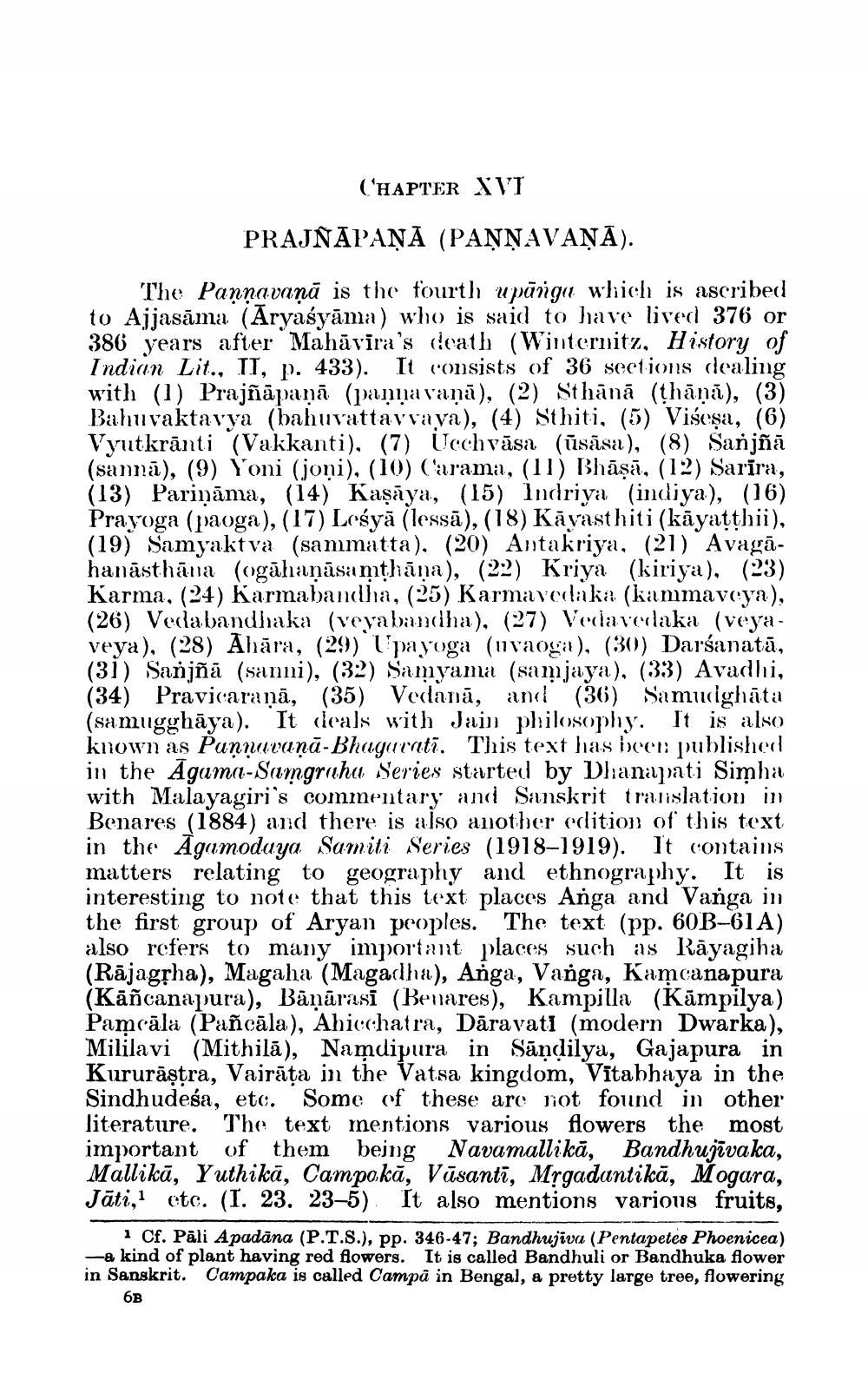________________
CHAPTER XVI
PRAJÑĀPAŅĀ (PAŅṆAVAṆĀ).
The Pannavana is the fourth upanga which is ascribed to Ajjasama (Aryasyama) who is said to have lived 376 or 386 years after Mahavira's death (Winternitz, History of Indian Lit., II, p. 433). It consists of 36 sections dealing with (1) Prajñāpaņā (panṇavaņā), (2) Sthānā (thāņā), (3) Bahuvaktavya (bahuvattavvaya), (4) Sthiti, (5) Viseṣa, (6) Vyutkranti (Vakkanti), (7) Ucchvāsa (ūsāsa), (8) Sanjñā (sanna), (9) Yoni (joni), (10) Carama, (11) Bhāṣā, (12) Sarīra, (13) Parinama, (14) Kaṣaya, (15) Indriya (indiya), (16) Prayoga (paoga), (17) Lesya (lessä), (18) Kayasthiti (kayaṭṭhii), (19) Samyaktva (sammatta). (20) Antakriya, (21) Avagāhanasthāna (ogāhaṇāsamthāna), (22) Kriya (kiriya), (23) Karma, (24) Karmabandha, (25) Karmavedaka (kammaveya), (26) Vedabandhaka (veyabandha), (27) Vedavedaka (veyaveya), (28) Ahāra, (29) Upayoga (nvaoga), (30) Darśanatā, (31) Sanjñā (sanni), (32) Samyama (samjaya), (33) Avadhi, (34) Pravicaraṇā, (35) Vedana, and (36) Samudghata (samugghāya). It deals with Jain philosophy. It is also known as Pannavaṇā-Bhagavati. This text has been published in the Agama-Samgraha Series started by Dhanapati Simha with Malayagiri's commentary and Sanskrit translation in Benares (1884) and there is also another edition of this text in the Agamodaya Samiti Series (1918-1919). It contains matters relating to geography and ethnography. It is interesting to note that this text places Anga and Vanga in the first group of Aryan peoples. The text (pp. 60B-61A) also refers to many important places such as Rayagiha (Rajagṛha), Magaha (Magadha), Anga, Vanga, Kamcanapura (Kañcanapura), Banarasi (Benares), Kampilla (Kampilya) Pamcala (Pañcala), Ahicchatra, Dāravati (modern Dwarka), Mililavi (Mithila), Namdipura in Sandilya, Gajapura in Kururāṣṭra, Vairața in the Vatsa kingdom, Vitabhaya in the Sindhudeśa, etc. Some of these are not found in other literature. The text mentions various flowers the most important of them being Navamallikā, Bandhujivaka, Mallika, Yuthika, Campokā, Vūsanti, Mrgadantikā, Mogara, Jati, etc. (I. 23. 23-5) It also mentions various fruits,
1 Cf. Pāli Apadāna (P.T.S.), pp. 346-47; Bandhujiva (Pentapetes Phoenicea) -a kind of plant having red flowers. It is called Bandhuli or Bandhuka flower in Sanskrit. Campaka is called Campa in Bengal, a pretty large tree, flowering
6B




